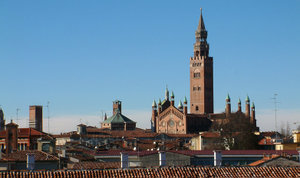Cremona, Italy
| Cremona | ||
|---|---|---|
| Comune | ||
|
Comune di Cremona Municipality of Cremona |
||

Panorama of Cremona
View of Cremona |
||
|
||
| Location of Cremona in Italy | ||
| Coordinates: 45°08′N 10°02′E / 45.133°N 10.033°ECoordinates: 45°08′N 10°02′E / 45.133°N 10.033°E | ||
| Country | Italy | |
| Region | Lombardy | |
| Province / Metropolitan city | Cremona (CR) | |
| Government | ||
| • Mayor | Gianluca Galimberti (PD) | |
| Area | ||
| • Total | 69.7 km2 (26.9 sq mi) | |
| Elevation | 47 m (154 ft) | |
| Population (31 December 2014) | ||
| • Total | 71,657 | |
| • Density | 1,000/km2 (2,700/sq mi) | |
| Demonym(s) | Cremonesi | |
| Time zone | CET (UTC+1) | |
| • Summer (DST) | CEST (UTC+2) | |
| Postal code | 26100 | |
| Dialing code | 0372 | |
| Patron saint | St. Omobono | |
| Saint day | 13 November | |
| Website | Official website | |
Cremona [kreˈmoːna] ![]() listen (Emilian: Carmona, Lombard: Cremùna) is a city and comune in northern Italy, situated in Lombardy, on the left bank of the Po River in the middle of the Pianura Padana (Po valley). It is the capital of the province of Cremona and the seat of the local city and province governments. The city of Cremona is especially noted for its musical history and traditions, including some of the earliest and most renowned luthiers, such as Giuseppe Guarneri, Antonio Stradivari, and several members of the Amati family.
listen (Emilian: Carmona, Lombard: Cremùna) is a city and comune in northern Italy, situated in Lombardy, on the left bank of the Po River in the middle of the Pianura Padana (Po valley). It is the capital of the province of Cremona and the seat of the local city and province governments. The city of Cremona is especially noted for its musical history and traditions, including some of the earliest and most renowned luthiers, such as Giuseppe Guarneri, Antonio Stradivari, and several members of the Amati family.
Cremona is first mentioned in history as a settlement of the Cenomani, a Gallic (Celtic) tribe that arrived in the Po valley around 400 BC. However, the name Cremona most likely dates back to earlier settlers and puzzled the ancients, who gave many fanciful interpretations. In 218 BC the Romans established on that spot their first military outpost (a colonia) north of the Po river, and kept the old name. Cremona and nearby Placentia (modern Piacenza, on the south bank of the Po), were founded in the same year, as bases for penetration into what became the Roman Province of Gallia Cisalpina (Cisalpine Gaul). Cremona quickly grew into one of the largest towns in northern Italy, as it was on the main road connecting Genoa to Aquileia, the Via Postumia. It supplied troops to Julius Caesar and benefited from his rule, but later supported Marcus Iunius Brutus and the Senate in their conflict with Augustus, who, having won, in 40 BC confiscated Cremona's land and redistributed it to his men. The famous poet Virgil, who went to school in Cremona, had to forfeit his ancestral farm ("too close to wretched Cremona"), but later regained it. The city's prosperity continued to increase until 69 AD, when it was destroyed in the Second Battle of Bedriacum by the troops of Vespasian, fighting to install him as Emperor against his rival Vitellius. Cremona was rebuilt with the help of Vespasian himself, but it seems to have failed to regain its former prosperity as it disappeared from history until the 6th century, when it resurfaced as a military outpost of the Eastern Roman (Byzantine) Empire during the Gothic War.
...
Wikipedia


